Edible spike rush, Chinese water-chestnut
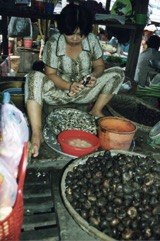
A tropical plant. It suits tropical and subtropical locations. It suits humid monsoonal conditions. It is found in the Philippines in open wet places and shallow water throughout the islands. It grows in fresh water swampy grounds or in shallow water. It grows in wetlands. It is also found in rice fields. It needs at least 220 frost free days. It needs a soil temperature above 14-15.5°C for germination of the corms. It needs a pH of 6.9-7.3. It can be grown up to 1,200 m altitude. It suits plant hardiness zones 9-12.
Also known as:
Ankurladj, Apulid, Biqi, Buslig, Chee-Chang, Chikai, Chinese Water Chestnut, Go nung, Ground-chestnut, Haeo cheen, Haeo-song krathiem, Inu kuro guwai, Kakthum, Kirlinja, Kokthum, Kurogu-wai, Kuwai, Li zi, M'pofa, Ma Ti, Ma-Tai, Macre, Mampufa, Mem plong khtim, Okuroguwai, Pani phul, Po-chi, Singhara, Tall spike-rush, Tike, Uchaga-lane, 'Utu'utu, Waterchestnut, Waternut, Wetmye-u, Ye thit eir thee
Synonyms
- Andropogon dulce Burm. f.
- Bolboschoenus maritimus subsp. tuberosus (Desf.) J. Sojak
- Eleocharis austrocaledonica Vieill.
- Eleocharis dulcis var. tuberosa (Schult.) T. Koyama
- Eleocharis equisetina J. Presl. & C. Presl
- Eleocharis esculenta Vieill. Eleocharis indica (Lour.) Druce
- Eleocharis plantaginea R.Br.
- Eleocharis plantaginoidea W.F.Wight [Illegitimate]
- Eleocharis sphacelata Boeck.
- Eleocharis tuberosus Roem & Schult.
- Eleocharis tumida (Roxb.) Schult.
- Limnochloa plantaginea (Retz.) Nees
- Limnochloa tumida (Roxb.) Nees
- Scirpus dubius Roxb.
- Scirpus plantagineus Retz.
- Scirpus plataginoides Rottb.
- Scirpus tuberosus Roxb. [Illegitimate]
- Scirpus tumidus Roxb.
Edible Portion
- Tubers, Corms, Vegetable, Roots
Where does Edible spike rush grow?
Found in: Africa, American Samoa, Asia, Australia, Botswana, Burkina Faso, Cambodia, China, East Africa, East Timor, Fiji, FSM, Gambia, Ghana, Guam, Guinea, Guinée, Guinea-Bissau, Hawaii, India, Indochina, Indonesia, Japan, Japan-Ryukyu Islands, Korea, Laos, Liberia, Madagascar, Malaysia, Mali, Micronesia, Mozambique, Myanmar, New Caledonia, Nigeria, North America, Northeastern India, Pacific, Pakistan, Papua New Guinea, PNG, Philippines, Pohnpei, SE Asia, Senegal, Sierra Leone, Singapore, South Africa - Natal, Southern Africa, Sri Lanka, Taiwan, Tasmania, Thailand, Timor-Leste, Tonga, United States, Vietnam, West Africa
Notes: There are about 160-200 Eleocharis species. There are 60 species in tropical America.
Status: It is a commercially cultivated vegetable. The corms are canned and exported. They are sold in local markets.
Growing Edible spike rush, Chinese water-chestnut
Cultivation: Plants can be grown by division or tubers. They are put in holes 20-30 cm deep. Fields are flooded after planting then allowed to drain. When top growth is 20-30 cm high fields are flooded to at least 10-12.5 cm. A spacing of 75 cm x 75 cm is suitable. 500 kg of corms per hectare are required for planting.
Edible Uses: The tubers are cooked and eaten. The corms can be eaten raw, roasted or boiled after they have been peeled. Normally, they are cut into small slices and added to soup or to fish and meat dishes. They can be sweetened for desserts.
Production: Corms mature after 7-8 months. Yields of 20-40 t per ha are possible.
Nutrition Info
per 100g edible portion| Edible Part | Energy (kcal) | Protein (g) | Iron (mg) | Vitamin A (ug) | Vitamin c (mg) | Zinc (mg) | % Water |
|---|---|---|---|---|---|---|---|
| Corm | 64 | 1.4 | 0.7 | 0 | 5 | 0.5 | 79.6 |
| Corm drier | 152 | 3.7 | 95 | - | 52 | 1.9 | 50.8 |
Edible spike rush, Chinese water-chestnut Photos

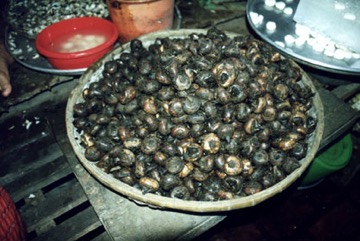
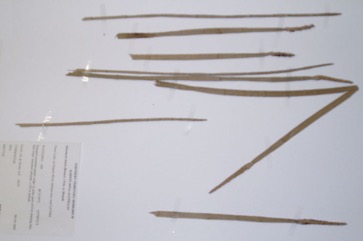
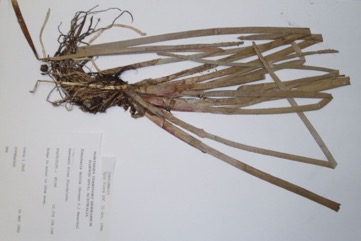
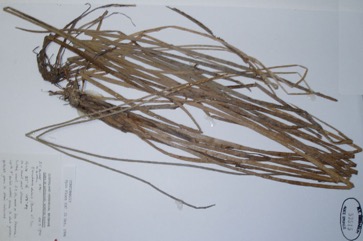
References
Ambasta, S.P. (Ed.), 2000, The Useful Plants of India. CSIR India. p 192
Anderson, E. F., 1993, Plants and people of the Golden Triangle. Dioscorides Press. p 210
Barrau, J., 1976, Subsistence Agriculture in Polynesia and Micronesia. Bernice P. Bishop Museu, Bulletin 223 Honolulu Hawaii. Kraus reprint. p 59
Bindon, P., 1996, Useful Bush Plants. Western Australian Museum. p 110
Bodkin, F., 1991, Encyclopedia Botanica. Cornstalk publishing, p 378
Brouk, B., 1975, Plants Consumed by Man. Academic Press, London. p 142
Brown, W. H., 1920, Wild Food Plants of the Philippines. Bureau of Forestry Bulletin No. 21 Manila. p 28
Burkill, H. M., 1985, The useful plants of west tropical Africa, Vol. 1. Kew.
Burkill, I.H., 1966, A Dictionary of the Economic Products of the Malay Peninsula. Ministry of Agriculture and Cooperatives, Kuala Lumpur, Malaysia. Vol 1 (A-H) p 921
Cancilla, D., 2018, Ethnobotanical and Ethnozoological Values Desktop Assessment - Eliwana Project. p 39
Cheifetz, A., (ed), 1999, 500 popular vegetables, herbs, fruits and nuts for Australian Gardeners. Random House p 66
Cherikoff, V. & Isaacs, J., The Bush Food Handbook. How to gather, grow, process and cook Australian Wild Foods. Ti Tree Press, Australia p 126, 199
Chew, M. & Morgan, W., 1999, Access to Asian Foods Newsletter, Vic Govt., Australia Issue 5
Cowie, I, 2006, A Survey of Flora and vegetation of the proposed Jaco-Tutuala-Lore National Park. Timor-Lests (East Timor) www.territorystories.nt/gov.au p 46
Cribb, A.B. & J.W., 1976, Wild Food in Australia, Fontana. p 157
Cundall, P., (ed.), 2004, Gardening Australia: flora: the gardener's bible. ABC Books. p 533
Elliot, W.R., & Jones, D.L., 1984, Encyclopedia of Australian Plants suitable for cultivation. Vol 3. Lothian. p 394
Facciola, S., 1998, Cornucopia 2: a Source Book of Edible Plants. Kampong Publications, p 90
Flora of Pakistan. www.eFloras.org
Foo, J. T. S.(ed), 1996, A Guide to Common Vegetables. Singapore Science Foundation. p 68
Food Composition Tables for use in East Asia FAO http://www.fao.org/infoods/directory No. 598
Franklin, J., Keppel, G., & Whistler, W., 2008, The vegetation and flora of Lakeba, Nayau and Aiwa Islands, Central Lau Group, Fiji. Micronesica 40(1/2): 169–225, 2008
Garde, M., et al, 2003, A Preliminary List of Kundedjnjenghmi Plant Names. Northern Land Council. (Arnhem Land, Australia)
Hedrick, U.P., 1919, (Ed.), Sturtevant's edible plants of the world. p 287 (As Eleocharis tuberosa)
Heywood, V.H., Brummitt, R.K., Culham, A., and Seberg, O., 2007, Flowering Plant Families of the World. Royal Botanical Gardens, Kew. p 364
Hibbert, M., 2002, The Aussie Plant Finder 2002, Florilegium. p 92
Hiddins, L., 1999, Explore Wild Australia with the Bush Tucker Man. Penguin Books/ABC Books. p 163
Hu, Shiu-ying, 2005, Food Plants of China. The Chinese University Press. p 299
Isaacs, J., 1987, Bush Food, Aboriginal Food and Herbal Medicine. Weldons. p 91, 96
Jacquat, C., 1990, Plants from the Markets of Thailand. D.K. Book House p 120 (As Eleocharis tuberosa)
Jain et al, 2011, Dietary Use and Conservation Concern of Edible Wetland Plants at Indo-Burma Hotspot: A Case Study from Northeast India. Journal of Ethnobiology and Ethnomedicine 7:29 p 6
Jardin, C., 1970, List of Foods Used In Africa, FAO Nutrition Information Document Series No 2.p 15
Kay, D. E., 1973, Root Crops, Digest 2, Tropical Products Institute, London, p 43
Kays, S. J., and Dias, J. C. S., 1995, Common Names of Commercially Cultivated Vegetables of the World in 15 languages. Economic Botany, Vol. 49, No. 2, pp. 115-152
Kenneally, K.E., Edinger, D. C., and Willing T., 1996, Broome and Beyond, Plants and People of the Dampier Peninsula, Kimberley, Western Australia. Department of Conservation and Land Management. p 206
Kiple, K.F. & Ornelas, K.C., (eds), 2000, The Cambridge World History of Food. CUP p 1876
Konsam, S., et al, 2016, Assessment of wild leafy vegetables traditionally consumed by the ethnic communities of Manipur, northeast India. Journal of Ethnobiology and Ethnomedicine, 12:9
Larkcom, J., 1991, Oriental Vegetables, John Murray, London, p125
Lazarides, M. & Hince, B., 1993, Handbook of Economic Plants of Australia, CSIRO. p 88
Leach, G.J., & Osborne, P.L., 1985, Freshwater Plants of Papua New Guinea. UPNG Press, p 112
Lembaga Biologi Nasional, 1977, Ubi-Ubian, Balai Pustaka, Jakarta. p 74
Lim, T. K., 2015, Edible Medicinal and Non Medicinal Plants. Volume 9, Modified Stems, Roots, Bulbs. Springer p 40, 76
Low, T., 1991, Wild Food Plants of Australia. Australian Nature FieldGuide, Angus & Robertson. p 53
Low, T., 1992, Bush Tucker. Australia’s Wild Food Harvest. Angus & Robertson. p 109
Monsalud, M.R., Tongacan, A.L., Lopez, F.R., & Lagrimas, M.Q., 1966, Edible Wild Plants in Philippine Forests. Philippine Journal of Science. p 457
Norrington, L., & Campbell, C., 2001, Tropical Food Gardens. Bloomings Books. p 40
Norrington, L., & Campbell, C., 2001, Tropical Food Gardens. Bloomings Books. p 40 (As Eleocharis tuberosa)
Ochse, J.J. et al, 1931, Vegetables of the Dutch East Indies. Asher reprint. p 217
Ogle, B. M., et al, 2003, Food, Feed or Medicine: The Multiple Functions of Edible Wild Plants in Vietnam. Economic Botany 57(1): 103-117
Paczkowska, G. & Chapman, A.R., 2000, The Western Australian Flora. A Descriptive Calatogue. Western Australian Herbarium. p 46
Phon, P., 2000, Plants used in Cambodia. © Pauline Dy Phon, Phnom Penh, Cambodia. p 271
Plants for a Future database, The Field, Penpol, Lostwithiel, Cornwall, PL22 0NG, UK. http://www.scs.leeds.ac.uk/pfaf/
Romanowski, N., 2007, Edible Water Gardens. Hyland House. p 95
Schneider, E., 2001, Vegetables from Amaranth to Zucchini: The essential reference. HarperCollins. p 694
Simpson, D. A. & Inglis, C. A., 2001, Cyperaceae of Economic, Ethnobotanical and Horticultural Importance: A checklist. Kew Bulletin Vol. 56, No. 2 (2001), pp. 257-360
Singh, H.B., Arora R.K.,1978, Wild edible Plants of India. Indian Council of Agricultural Research, New Delhi. p 13
Slocum, P.D. & Robinson, P., 1999, Water Gardening. Water Lilies and Lotuses. Timber Press. p 78
Smith, A.C., 1979, Flora Vitiensis Nova, Lawaii, Kuai, Hawaii, Volume 1 p 238
Solomon, C., 2001, Encyclopedia of Asian Food. New Holland. p 404
Staples, G.W. and Herbst, D.R., 2005, A tropical Garden Flora. Bishop Museum Press, Honolulu, Hawaii. p 657
Stone, B. C., 1970, The Flora of Guam. A Manual for the Identification of the Vascular Plants of the Island. Micronesica. Journal of the University of Guam. p 146
Swapna, M. M. et al, 2011, A review on the medicinal and edible aspects of aquatic and wetland plants of India. J. Med. Plants Res. 5 (33) pp. 7163-7176
Thomson, G. & Morgan, W., (Ed.) 2000, Access to Asian Foods Newsletter, Vic Govt., Australia Issue 7, Issue 33 - Booklet.
Tindall, H. D., 1983, Vegetables in the Tropics, Macmillan p 198
Tiwi Plants and Animals. 2001, Aboriginal flora and fauna knowledge from Bathurst and Melville Islands, northern Australia. Northern Territory Botanical Bulletin; No. 24 p 45
USDA, ARS, National Genetic Resources Program. Germplasm Resources Information Network - (GRIN). [Online Database] National Germplasm Resources Laboratory, Beltsville, Maryland. Available: www.ars-grin.gov/cgi-bin/npgs/html/econ.pl (10 April 2000)
Valder, P., 1999, The Garden Plants of China. Florilegium. p 228
van Wyk, B., 2005, Food Plants of the World. An illustrated guide. Timber press. p 185
Vigilante, T., et al, 2013, Island country: Aboriginal connections, values and knowledge of the Western Kimberley islands in the context of an island biological survey. Records of the Western Australian Museum Supplement 81: 145-182
Vita Rumphii 186. 1833
Wheeler, J.R.(ed.), 1992, Flora of the Kimberley Region. CALM, Western Australian Herbarium, p 1063
Wickens, G.E., 1995, Edible Nuts. FAO Non-wood forest products. FAO, Rome. p160
Wightman, Glenn et al. 1992, Mangarrayi Ethnobotany: Aboriginal Plant Use from the Elsey Area Northern Australia. Northern Territory Botanical Bulletin No 15. Parks and Wildlife Commission of the Northern Territory. p 20
Wightman, Glenn et al. 1994, Gurindji Ethnobotany: Aboriginal Plant Use from Daguragu Northern Australia. Northern Territory Botanical Bulletin No 18. Parks and Wildlife Commission of the Northern Territory. p 21
Woodward, P., 2000, Asian Herbs and Vegetables. Hyland House. p 67
World Checklist of Useful Plant Species 2020. Royal Botanic Gardens, Kew
Yuncker, T.G., 1959, Plants of Tonga, Bernice P. Bishop Museum, Hawaii, Bulletin 220. p 71
Yunupinu Banjgul, Laklak Yunupinu-Marika, et al. 1995, Rirratjinu Ethnobotany: Aboriginal Plant Use from Yirrkala, Arnhem Land, Australia. Northern Territory Botanical Bulletin No 21. Parks and Wildlife Commission of the Northern Territory. p 36
Zhang, Y., et al, 2014, Diversity of wetland plants used traditionally in China: a literature review. Journal of Ethnobiology and Ethnomedicine. 10:72